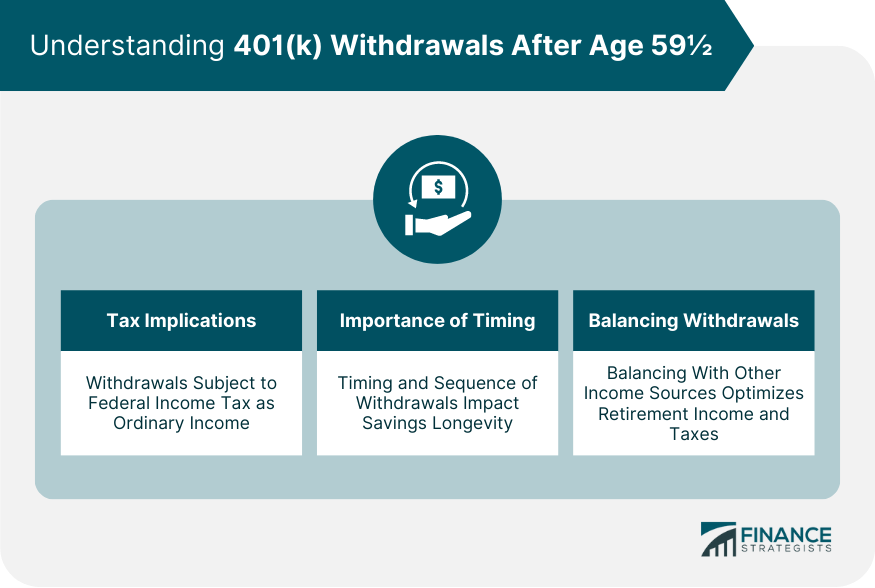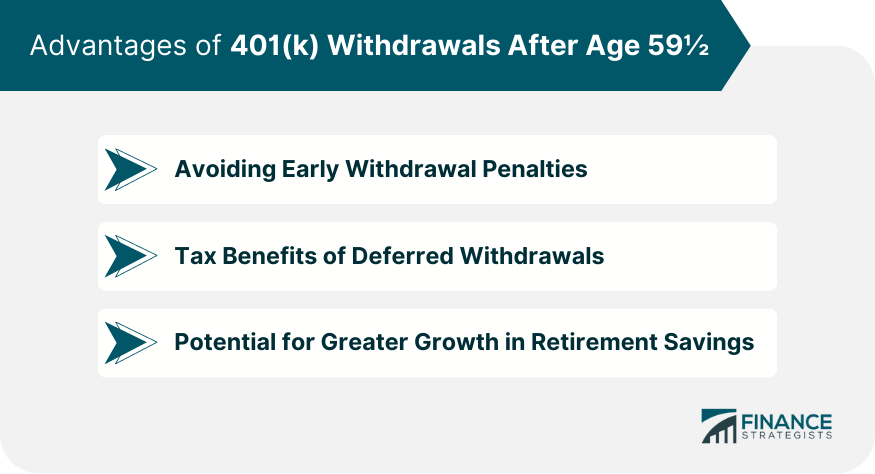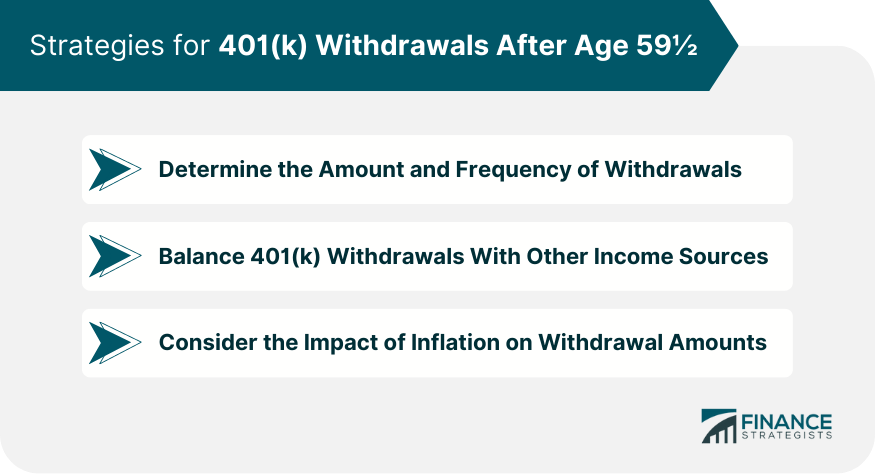Navigating 401(k) withdrawals can be intricate, but with the right knowledge, it's a manageable task. Once you cross the age of 59½, you gain the freedom to withdraw from your 401(k) without being hit by a 10% early withdrawal penalty. However, it's important to understand that these withdrawals aren't tax-free. They are considered ordinary income and subject to federal income tax. When you start taking distributions from your 401(k), the withdrawals are taxed as ordinary income. The rate depends on your total income and filing status. It's advisable to consult with a tax advisor to ensure you are appropriately managing your tax obligations. The sequence of withdrawals from different retirement accounts can significantly impact the longevity of your savings. Balancing withdrawals from your 401(k) with other income sources can help optimize your retirement income and minimize the tax burden. By waiting until you're 59½, you avoid the 10% early withdrawal penalty typically imposed on distributions taken before this age. This allows more of your money to continue growing tax-deferred, adding to your retirement income. The money in your 401(k) grows on a tax-deferred basis, meaning you don't pay taxes on the earnings until you withdraw them. This can result in substantial growth over the long term, especially if you're in a higher tax bracket during your working years than in retirement. Leaving your money in the 401(k) allows it to continue to grow tax-deferred. Over time, compounding can result in substantial growth, providing you with a larger nest egg when you eventually start making withdrawals. Deciding how much to withdraw from your 401(k) can be tricky. Withdrawing too much too soon can risk depleting your retirement savings while withdrawing too little can unnecessarily restrict your retirement lifestyle. A commonly used strategy is the "4% rule," which suggests withdrawing 4% of your portfolio in the first year of retirement and adjusting the amount each subsequent year for inflation. In retirement, you likely have several sources of income, such as Social Security, pensions, or annuities. Coordinating withdrawals from these various sources can optimize your retirement income and potentially reduce your overall tax burden. Inflation can erode the purchasing power of your retirement savings. When planning your 401(k) withdrawals, it's essential to account for inflation to maintain your standard of living throughout retirement. The rate at which you withdraw from your 401(k) can have a significant impact on how long your savings last. A high withdrawal rate can deplete your savings rapidly, especially in a down market. Conversely, a lower withdrawal rate can extend the longevity of your savings but may mean a more frugal lifestyle in retirement. The "4% rule" is a popular guideline for withdrawal rates. It suggests that you can withdraw 4% of your portfolio in the first year of retirement and adjust the amount each subsequent year for inflation without running out of money for at least 30 years. However, this is just a guideline and may not be suitable for everyone, depending on individual circumstances and market conditions. Recent legislation, like the SECURE Act, has brought about changes to 401(k) withdrawal rules. For instance, it raised the age for starting Required Minimum Distributions (RMDs) from 70½ to 72. Staying updated with such changes can ensure you're taking full advantage of your 401(k). The SECURE Act has made significant changes to 401(k) withdrawal rules. One of the key changes is the increase in the age to begin RMDs from 70½ to 72, allowing more time for tax-deferred growth. This change can impact your withdrawal strategy and potentially your overall retirement income. The Rule of 55 is an IRS provision that allows you to withdraw from your 401(k) without penalty if you are 55 or older and have left your job, whether by choice or not. While this rule can provide financial relief in certain situations, it's essential to weigh the benefits against potential long-term impacts on your retirement savings. The IRS allows for hardship withdrawals under specific circumstances, such as avoiding foreclosure on your home or paying for certain medical expenses. However, these withdrawals are still subject to income tax and could potentially trigger an early withdrawal penalty if you're under age 59½. Once you turn 72, IRS rules require you to start taking RMDs from your 401(k) each year. The exact amount depends on your age and the balance in your account at the end of the previous year. Failing to take the RMD can result in a hefty penalty – 50% of the amount you should have withdrawn. If you don't need the RMD for living expenses, you might consider reinvesting it in a taxable account to continue growing your wealth. You could also donate the RMD to a qualified charity, which can provide a tax benefit. It's essential to plan your strategy to manage RMDs effectively. Understanding the nuances of 401(k) withdrawals post age 59½ is essential to maximizing your retirement income and managing tax implications. Waiting until 59½ to withdraw allows you to avoid early withdrawal penalties, benefiting from tax-deferred growth in your account. However, it's crucial to strategically plan the timing and amount of your withdrawals, considering factors like your total retirement income sources, inflation, and changes in legislation like the SECURE Act. The "4% Rule" can serve as a guideline, but it's not one-size-fits-all. The Rule of 55 and hardship withdrawals offer flexibility in certain circumstances. Once you turn 72, managing your Required Minimum Distributions efficiently becomes vital, as failure to do so can lead to substantial penalties. Exploring options like reinvesting RMDs or charitable contributions can potentially enhance your tax benefits. A tailored strategy that reflects your personal circumstances can help optimize your retirement savings and ensure financial stability.Understanding 401(k) Withdrawals After Age 59½
Tax Implications of Withdrawals Post-59½
Importance of Timing and Sequence of Withdrawals

Advantages of 401(k) Withdrawals After Age 59½
Avoiding Early Withdrawal Penalties
Tax Benefits of Deferred Withdrawals
Potential for Greater Growth in Retirement Savings

Strategies for 401(k) Withdrawals After Age 59½
Determine the Amount and Frequency of Withdrawals
Balance 401(k) Withdrawals With Other Income Sources
Consider the Impact of Inflation on Withdrawal Amounts

Impact of Withdrawal Rate on 401(k) Balance
Understand Withdrawal Rates and Their Effects
Examine the "4% Rule" and Its Relevance
Legal and Policy Aspects of 401(k) Withdrawals After Age 59½
Recent Legislative Changes Influencing 401(k) Withdrawals
Impact of the SECURE Act on Withdrawal Strategies
Special Considerations for 401(k) Withdrawals
Rule of 55
Hardship Withdrawals
Mandatory 401(k) Withdrawals: Required Minimum Distributions (RMDs)
Understand When and How RMDs Apply
Strategies to Manage RMDs
Bottom Line
401(k) Withdrawals After Age 59½ FAQs
The "4% Rule" is a guideline suggesting that you can withdraw 4% of your retirement portfolio in the first year and then adjust that amount each subsequent year for inflation. This is designed to provide a steady stream of funds while also maintaining an account balance that keeps income flowing through retirement.
No, 401(k) withdrawals are treated as ordinary income and are subject to federal income tax. The tax rate depends on your total income and filing status for the year. While you avoid an early withdrawal penalty after 59½, taxes are still due on withdrawals.
The Rule of 55 is a provision from the IRS that allows individuals 55 or older who have left their job to make withdrawals from their 401(k) without incurring the usual 10% early withdrawal penalty. It provides a way to access retirement funds early in certain circumstances.
If you fail to take your RMDs starting at age 72, the IRS imposes a penalty which is 50% of the amount that should have been withdrawn. For example, if your RMD was $4,000 and you didn't take it, you'd be hit with a $2,000 penalty.
If you don't need your RMDs for living expenses, you could consider reinvesting them in a taxable account for continued growth. Alternatively, you could use your RMDs for charitable donations, which might also provide a tax advantage. It's advisable to consult with a financial advisor to determine the best approach based on your personal circumstances.
True Tamplin is a published author, public speaker, CEO of UpDigital, and founder of Finance Strategists.
True is a Certified Educator in Personal Finance (CEPF®), author of The Handy Financial Ratios Guide, a member of the Society for Advancing Business Editing and Writing, contributes to his financial education site, Finance Strategists, and has spoken to various financial communities such as the CFA Institute, as well as university students like his Alma mater, Biola University, where he received a bachelor of science in business and data analytics.
To learn more about True, visit his personal website or view his author profiles on Amazon, Nasdaq and Forbes.











